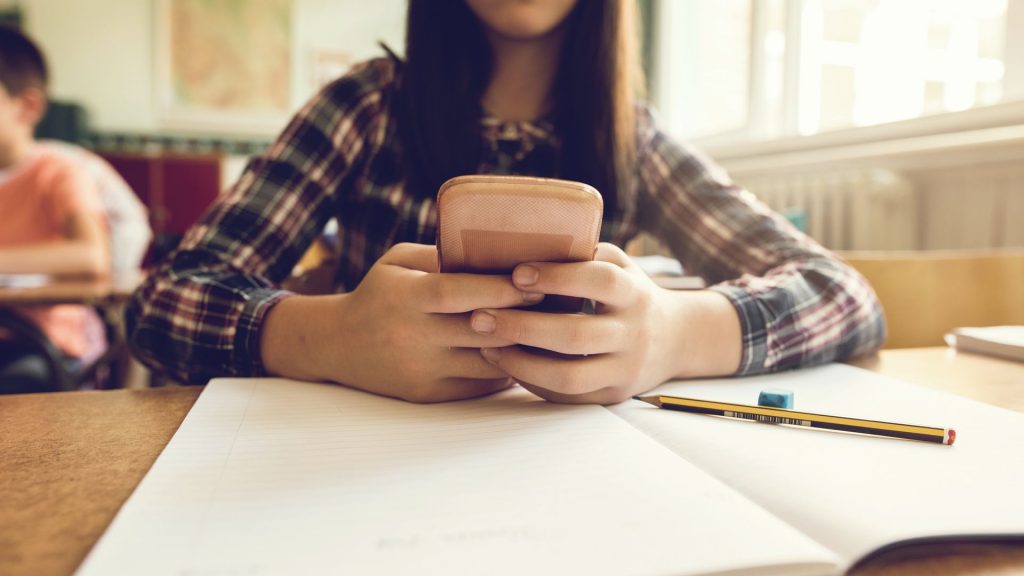Phones out, learning in: New Alabama law changes school culture

The buzz of cell phones is absent from Alabama classrooms this fall. A new statewide ban on devices during class is shifting the focus back to teachers and lessons, and educators say the difference is already showing.
“Taking phones out of schools is really transforming the environment. It’s transforming the culture, because now kids are engaging again,” said David Monahan, Fairplay campaign director. “Now they’re paying attention to the teacher again. Now they’re having fun in the hallways and in the lunchroom, and that’s the way school should be.”
Alabama classrooms go phone-free
An Alabama high school teacher said the classroom feels different this school year after eight years of frustration. In a viral TikTok video, he credited the state’s new phone ban with keeping students locked into lessons instead of their screens.
“All of my students, 100% of them, took notes in my class, did their assignment, asked for help when they got stuck and turned it in,” Jonathan Buchwaler said in the video.
The FOCUS Act takes effect
Alabama Gov. Kay Ivey signed the FOCUS Act this summer, banning smartphones and other wireless devices in public schools during the day, except for emergencies or authorized classroom use.
State leaders say the goal is to cut distractions and help students stay engaged. The law also requires local school boards to adopt internet safety rules for school-issued devices. It directs the state to provide social media safety training before students enter eighth grade.
Fairplay and the push for phone-free schools
Fairplay, a nonprofit that promotes safer online environments for kids, has also pushed for phone-free schools. In an interview with SAN, Monahan said their efforts, along with those of other groups, have helped drive legislation in 18 states and the District of Columbia to limit or remove phones from classrooms.
“Schools are just places where too many children have their heads buried in their phones. They’re sitting in class, distracted by phones. They’re in the hallway and in the lunchroom, ignoring one another,” said Monahan. “Teachers are having a hard time engaging young people. And you know, school is not only about education, it’s also about social emotional development.”
Monahan said phone bans work best if they cover the entire school day, not just classroom time. In some states, students can still check their devices between classes or at lunch. While that limits distractions during lessons, he argues it does not remove the constant pull of social media.
Fairplay points to research showing apps are designed to capture attention, promote popularity and expose teens to harmful content — from bullying and body image pressures to dangerous online challenges.
A study published in JAMA Psychiatry found that social media can affect teens’ mental health, contributing to anxiety, depression and body image issues, especially for girls. Too much screen time can disrupt sleep, though it can also offer connection, self-expression and access to helpful resources.
Public opinion on phone bans
It’s not just advocacy groups and lawmakers pushing for change — public support is growing too. A Pew Research Center survey in June found that 74% of U.S. adults favor banning phones in middle and high school classrooms, up from 68% last year.
Nearly 44% now support banning student cellphones for the entire school day, up from 36% last fall. Still, about 46% oppose a full-day ban, and 10% aren’t sure where they stand.
“Removing phones from schools is not about a punishment. It’s really a gift. It’s giving kids the gift of engagement in their classroom and throughout the school,” Monahan said.
Phone-free policies across the U.S.
According to the KFF, a policy research organization, across the country, states are rolling out new laws to limit student cellphone use in schools. Arizona, Arkansas and New York now require districts to create policies restricting phones during the school day, with exceptions for emergencies, medical needs or classroom use. California’s Phone-Free School Act asks districts to adopt phone limits or full bans by 2026, while Florida blocks social media on district Wi-Fi and adds digital literacy lessons starting in sixth grade.
Indiana, Ohio and Louisiana give schools flexibility to set phone rules, while Minnesota, South Carolina and Virginia provide guidance and support for implementing phone-free policies statewide.
Students push back on Texas phone ban
A new Texas law bans cell phones and personal devices in schools, even for students 18 and older. A Change.org petition argues the rule is unfair and removes a key tool for learning, communication and safety.
A student leading the petition, which has over 139,000 signatures, says phones were crucial for staying informed during real threats, including nearby school incidents and false lockdowns. Without quick access to texts and social media, important information could be missed.
The 2022 mass shooting at Robb Elementary in Uvalde, Texas, was one of the deadliest in U.S. history, killing 19 students and two teachers.
Many students say schools should prioritize safety and mental health rather than restricting devices. Responsible phone policies that balance learning, communication and security could offer a better solution.





